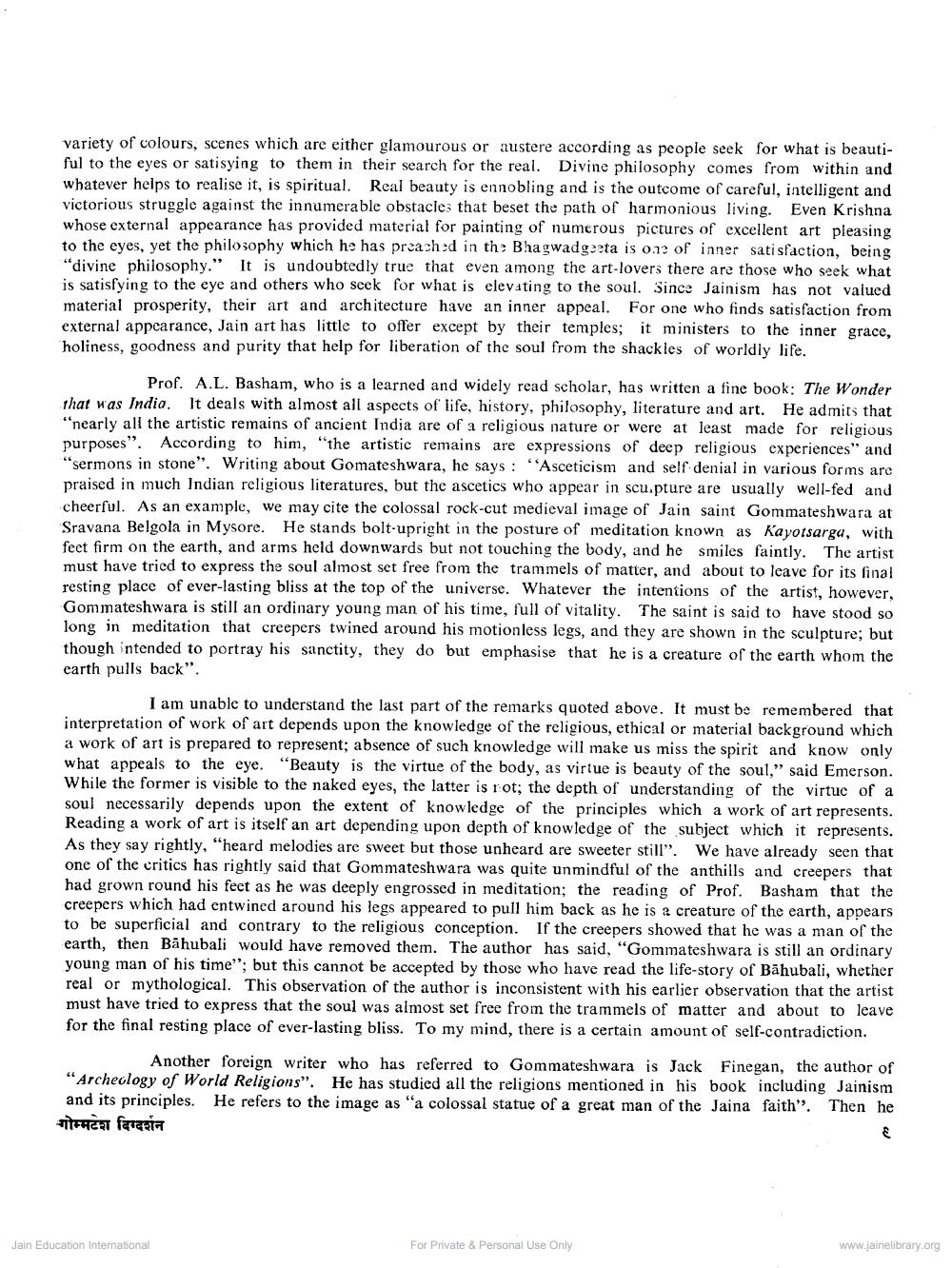________________
variety of colours, scenes which are either glamourous or austere according as people seek for what is beautiful to the eyes or satisying to them in their search for the real. Divine philosophy comes from within and whatever helps to realise it, is spiritual. Real beauty is ennobling and is the outcome of careful, intelligent and victorious struggle against the innumerable obstacles that beset the path of harmonious living. Even Krishna whose external appearance has provided material for painting of numerous pictures of excellent art pleasing to the eyes, yet the philosophy which he has preached in the Bhagwadgeeta is one of inner satisfaction, being "divine philosophy." It is undoubtedly true that even among the art-lovers there are those who seek what is satisfying to the eye and others who seek for what is elevating to the soul. Since Jainism has not valued material prosperity, their art and architecture have an inner appeal. For one who finds satisfaction from external appearance, Jain art has little to offer except by their temples; it ministers to the inner grace, holiness, goodness and purity that help for liberation of the soul from the shackles of worldly life.
Prof. A.L. Basham, who is a learned and widely read scholar, has written a fine book: The Wonder that was India. It deals with almost all aspects of life, history, philosophy, literature and art. He admits that "nearly all the artistic remains of ancient India are of a religious nature or were at least made for religious purposes". According to him, "the artistic remains are expressions of deep religious experiences" and "sermons in stone". Writing about Gomateshwara, he says: "Asceticism and self denial in various forms are praised in much Indian religious literatures, but the ascetics who appear in scu.pture are usually well-fed and cheerful. As an example, we may cite the colossal rock-cut medieval image of Jain saint Gommateshwara at Sravana Belgola in Mysore. He stands bolt-upright in the posture of meditation known as Kayotsarga, with feet firm on the earth, and arms held downwards but not touching the body, and he smiles faintly. The artist must have tried to express the soul almost set free from the trammels of matter, and about to leave for its final resting place of ever-lasting bliss at the top of the universe. Whatever the intentions of the artist, however, Gommateshwara is still an ordinary young man of his time, full of vitality. The saint is said to have stood so long in meditation that creepers twined around his motionless legs, and they are shown in the sculpture; but though intended to portray his sanctity, they do but emphasise that he is a creature of the earth whom the earth pulls back".
I am unable to understand the last part of the remarks quoted above. It must be remembered that interpretation of work of art depends upon the knowledge of the religious, ethical or material background which a work of art is prepared to represent; absence of such knowledge will make us miss the spirit and know only what appeals to the eye. "Beauty is the virtue of the body, as virtue is beauty of the soul," said Emerson. While the former is visible to the naked eyes, the latter is rot; the depth of understanding of the virtue of a soul necessarily depends upon the extent of knowledge of the principles which a work of art represents. Reading a work of art is itself an art depending upon depth of knowledge of the subject which it represents. As they say rightly, "heard melodies are sweet but those unheard are sweeter still". We have already seen that one of the critics has rightly said that Gommateshwara was quite unmindful of the anthills and creepers that had grown round his feet as he was deeply engrossed in meditation; the reading of Prof. Basham that the creepers which had entwined around his legs appeared to pull him back as he is a creature of the earth, appears to be superficial and contrary to the religious conception. If the creepers showed that he was a man of the earth, then Bahubali would have removed them. The author has said, "Gommateshwara is still an ordinary young man of his time”; but this cannot be accepted by those who have read the life-story of Bahubali, whether real or mythological. This observation of the author is inconsistent with his earlier observation that the artist must have tried to express that the soul was almost set free from the trammels of matter and about to leave for the final resting place of ever-lasting bliss. To my mind, there is a certain amount of self-contradiction.
Another foreign writer who has referred to Gommateshwara is Jack Finegan, the author of "Archeology of World Religions". He has studied all the religions mentioned in his book including Jainism and its principles. He refers to the image as "a colossal statue of a great man of the Jaina faith". Then he गोम्मटेश दिग्दर्शन
Jain Education International
For Private & Personal Use Only
www.jainelibrary.org




